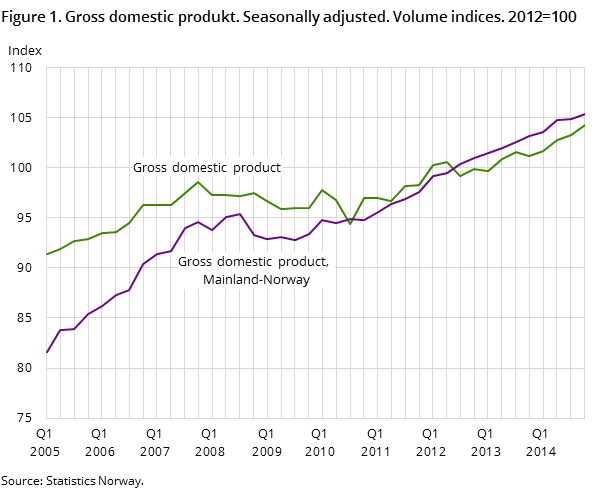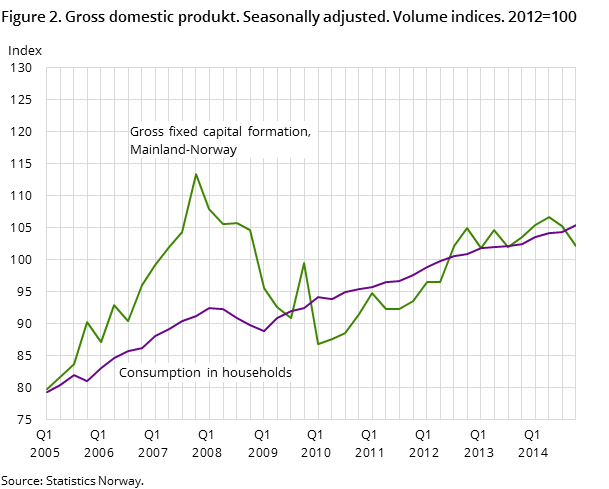Content
Published:
This is an archived release.
Moderate growth in Mainland GDP
According to preliminary seasonally-adjusted volume figures, Mainland Norway’s gross domestic product (GDP) grew 0.5 per cent in the 4th quarter of 2014. Moderate growth in the 1st quarter was followed by a sharp rise in the 2nd quarter and a weak growth in the 3rd quarter. In 2014, Mainland GDP grew 2.3 per cent.
| 2014 | 1st quarter 2014 | 2nd quarter 2014 | 3rd quarter 2014 | 4th quarter 2014 | |
|---|---|---|---|---|---|
| 1Figures for the last two years are preliminary. | |||||
| Gross domestic product | 2.2 | 0.5 | 1.1 | 0.5 | 0.9 |
| Gross domestic product Mainland Norway | 2.3 | 0.4 | 1.2 | 0.1 | 0.5 |
| Petroleum activities and ocean transport | 1.9 | 1.1 | 0.8 | 1.8 | 2.5 |
| Final domestic use of goods and services | 2.2 | -0.4 | 1.8 | 0.8 | -1.7 |
| Final consumption expenditure of households and NPISH | 2.1 | 1.0 | 0.7 | 0.1 | 1.0 |
| Final consumption expenditure of general government | 2.5 | 0.2 | 0.8 | 0.6 | 0.9 |
| Gross fixed capital formation (GFCF) | 1.2 | 0.7 | 1.2 | -1.5 | -2.7 |
| Total exports | 1.7 | 2.1 | -0.5 | 1.4 | 3.4 |
| Total imports | 1.6 | -0.3 | 1.0 | 2.8 | -3.7 |
| Employed persons | 1.1 | 0.2 | 0.3 | 0.3 | 0.2 |
| Total hours worked | 1.6 | 0.2 | 0.3 | 0.2 | 0.3 |


Value added in petroleum activities and ocean transport grew 2.5 per cent in the 4th quarter, which contributed to a growth in total GDP in the 4th quarter of 0.9 per cent. In 2014, total GDP was up 2.2 per cent.
Value added in manufacturing and mining increased by 0.3 per cent overall, which was a clear slowdown from previous quarters. This slowdown is partly explained by the developments in the food industry, especially the fishing industry, which had strong growth in the 2nd and 3rd quarters, but fell in the 4th quarter. A fall in raw materials also contributed to curb overall growth. Production of machinery, however, increased in the 4th quarter.
Construction fell by 0.6 per cent in the 4th quarter, after strong growth two quarters in a row. Electricity production increased slightly. For the year overall, production in the group ‘other goods’ was 4.3 per cent higher in 2014 than in 2013.
The activity level in service industries excluding general government showed moderate growth through 2014 and increased by 0.5 per cent in the 4th quarter. Value added in general government increased by 0.6 per cent in the same period.
Higher consumption of goods
Total household consumption rose by 1 per cent in the 4th quarter, after a weak 3rd quarter. Among other things, the growth in consumption of durable goods such as cars and furniture grew after two consecutive quarters of decline. Consumption of services also increased, with a clear growth in consumption of leisure services and hotel and restaurant services.
Direct purchases abroad by resident households grew by 0.3 per cent. In 2014, direct purchases abroad by resident households increased 4.4 per cent from 2013, which is a lower growth than we have seen in previous years.
In 2014, household consumption of goods was up 2.2 per cent; approximately the same growth as in 2013.
Decrease in investments
Gross fixed capital formation (GFCF) in Mainland Norway fell by 2.9 per cent in the 4th quarter. GFCF in manufacturing and mining rose in the 4th quarter and was 5 per cent higher in 2014 than the year before. Government investment was also high in 2014 compared with 2013, but declined in the last two quarters. In the 4th quarter, government investment fell 3.7 per cent and contributed to the decline in Mainland GFCF. Household investments in dwellings has been weak throughout 2014 and the decline in the 4th quarter was 3.1 per cent.
In the 4th quarter, petroleum GFCF was 1.3 per cent lower than the previous quarter. Investments peaked in the 3rd quarter of 2013, and then decreased gradually. In 2014, total petroleum GFCF was at the same level as in 2013.
Increased exports and reduced imports of traditional goods
Exports of traditional goods increased 1.5 per cent. There was an increase throughout all quarters in 2014. The increase in the 4th quarter was primarily pulled up by exports of machinery and other equipment as well as chemical and mineral products. Preliminary figures show growth in exports of services in the 4th quarter.
Imports of traditional goods fell for the third consecutive quarter, and showed a decline of 0.6 per cent in the 4th quarter.
From 2013 to 2014, total exports and imports increased by 1.7 and 1.6 per cent respectively.
Employment growth
Employment rose steadily throughout the year, and grew 0.2 per cent in the 4th quarter. Hours worked rose by 0.3 per cent in the same period.
Revisions of previous quarters
In conjunction with the release of figures for the 4th quarter, unadjusted figures for the first three quarters of the same year have been subject to minor revisions following the incorporation of new information. There is a small downward adjustment for all three quarters. The seasonally-adjusted GDP growth for Mainland Norway has been revised downwards in the 1st and 3rd quarters, by 0.2 and 0.3 percentage points respectively. For an overview of the revisions in the main aggregates in the last quarters, see table 48.
In connection with the release of figures for the 4th quarter, national accounts also publish new time series for the period between 1978 and 1995. This comes in the context of a main revision of the national accounts.
For more information on compilation methods and seasonal adjustment practice, please see About the statistics and On seasonal adjustment of the quarterly national accounts.
For an overview of the development in the GDP of some of our trading partners, please refer to the OECD statistics.
Main revision of the national accountsOpen and readClose
Statistics Norway has undertaken a main revision of the national accounts. The first results from this revision were published on 20 November 2014. The revisions are partly due to new international recommendations on national accounting and partly the result of improved methods of estimations and new sources.
Concepts and definitions in National AccountsOpen and readClose
For more information about definitions of the main concepts, variables and classifications in national accounts, see About the statistics, definitions.
How the figures are calculatedOpen and readClose
Four quarters in the Quarterly National Accounts (QNA) are preliminary annual figures until the Annual National Accounts (ANA) for year t are published in November in year t+2 and incorporated as a new base year in the QNA. Hence, 2011 is the base year in QNA when publishing data in May 2014.
In both ANA and QNA, the figures stripped of movements in prices are referred to as volume changes, or fixed price estimates in QNA, and this is done to identify the underlying cyclical pattern of the economy.
Note that in the time series in volume, the figures from the base year and onwards are fixed price figures, while data prior to the base year are chained volume figures. This means that additivity in volume is lost prior to the base year.
Contact
-
Pål Sletten
E-mail: pal.sletten@ssb.no
tel.: (+47) 99 29 06 84
-
Ingunn Sagelvmo
E-mail: ingunn.sagelvmo@ssb.no
tel.: (+47) 40 90 26 32
-
Pia Tønjum
E-mail: pia.tonjum@ssb.no
tel.: (+47) 48 99 12 07
-
Kristian Gimming
E-mail: kristian.gimming@ssb.no
tel.: (+47) 91 88 39 06
